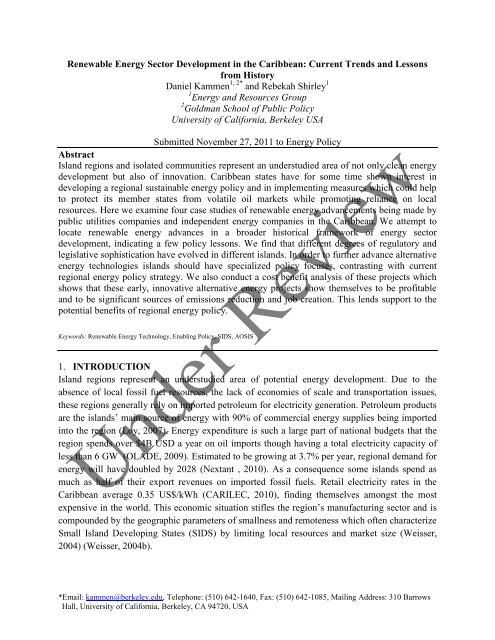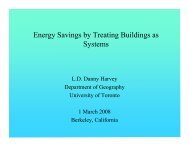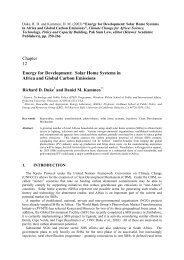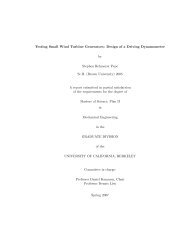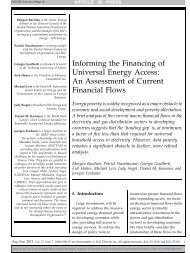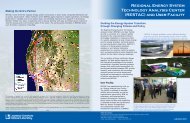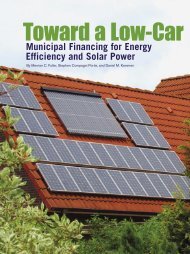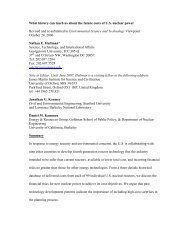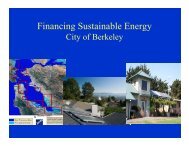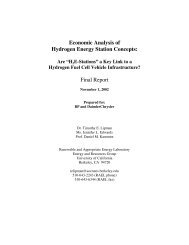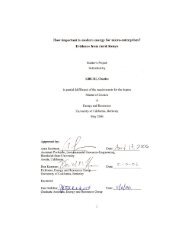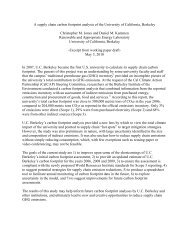Renewable Energy Sector Development in the Caribbean: Current ...
Renewable Energy Sector Development in the Caribbean: Current ...
Renewable Energy Sector Development in the Caribbean: Current ...
You also want an ePaper? Increase the reach of your titles
YUMPU automatically turns print PDFs into web optimized ePapers that Google loves.
<strong>Renewable</strong> <strong>Energy</strong> <strong>Sector</strong> <strong>Development</strong> <strong>in</strong> <strong>the</strong> <strong>Caribbean</strong>: <strong>Current</strong> Trends and Lessonsfrom HistoryDaniel Kammen 1, 2* and Rebekah Shirley 11 <strong>Energy</strong> and Resources Group2 Goldman School of Public PolicyUniversity of California, Berkeley USASubmitted November 27, 2011 to <strong>Energy</strong> PolicyAbstractIsland regions and isolated communities represent an understudied area of not only clean energydevelopment but also of <strong>in</strong>novation. <strong>Caribbean</strong> states have for some time shown <strong>in</strong>terest <strong>in</strong>develop<strong>in</strong>g a regional susta<strong>in</strong>able energy policy and <strong>in</strong> implement<strong>in</strong>g measures which could helpto protect its member states from volatile oil markets while promot<strong>in</strong>g reliance on localresources. Here we exam<strong>in</strong>e four case studies of renewable energy advancements be<strong>in</strong>g made bypublic utilities companies and <strong>in</strong>dependent energy companies <strong>in</strong> <strong>the</strong> <strong>Caribbean</strong>. We attempt tolocate renewable energy advances <strong>in</strong> a broader historical framework of energy sectordevelopment, <strong>in</strong>dicat<strong>in</strong>g a few policy lessons. We f<strong>in</strong>d that different degrees of regulatory andlegislative sophistication have evolved <strong>in</strong> different islands. In order to fur<strong>the</strong>r advance alternativeenergy technologies islands should have specialized policy focuses, contrast<strong>in</strong>g with currentregional energy policy strategy. We also conduct a cost benefit analysis of <strong>the</strong>se projects whichshows that <strong>the</strong>se early, <strong>in</strong>novative alternative energy projects show <strong>the</strong>mselves to be profitableand to be significant sources of emissions reduction and job creation. This lends support to <strong>the</strong>potential benefits of regional energy policy.Keywords: <strong>Renewable</strong> <strong>Energy</strong> Technology, Enabl<strong>in</strong>g Policy, SIDS, AOSIS1. INTRODUCTIONIsland regions represent an understudied area of potential energy development. Due to <strong>the</strong>absence of local fossil fuel resources, <strong>the</strong> lack of economies of scale and transportation issues,<strong>the</strong>se regions generally rely on imported petroleum for electricity generation. Petroleum productsare <strong>the</strong> islands’ ma<strong>in</strong> source of energy with 90% of commercial energy supplies be<strong>in</strong>g imported<strong>in</strong>to <strong>the</strong> region (Loy, 2007). <strong>Energy</strong> expenditure is such a large part of national budgets that <strong>the</strong>region spends over $4B USD a year on oil imports though hav<strong>in</strong>g a total electricity capacity ofless than 6 GW (OLADE, 2009). Estimated to be grow<strong>in</strong>g at 3.7% per year, regional demand forenergy will have doubled by 2028 (Nextant , 2010). As a consequence some islands spend asmuch as half of <strong>the</strong>ir export revenues on imported fossil fuels. Retail electricity rates <strong>in</strong> <strong>the</strong><strong>Caribbean</strong> average 0.35 US$/kWh (CARILEC, 2010), f<strong>in</strong>d<strong>in</strong>g <strong>the</strong>mselves amongst <strong>the</strong> mostexpensive <strong>in</strong> <strong>the</strong> world. This economic situation stifles <strong>the</strong> region’s manufactur<strong>in</strong>g sector and iscompounded by <strong>the</strong> geographic parameters of smallness and remoteness which often characterizeSmall Island Develop<strong>in</strong>g States (SIDS) by limit<strong>in</strong>g local resources and market size (Weisser,2004) (Weisser, 2004b).*Email: kammen@berkeley.edu, Telephone: (510) 642-1640, Fax: (510) 642-1085, Mail<strong>in</strong>g Address: 310 BarrowsHall, University of California, Berkeley, CA 94720, USA
Figure 1 Domestic Retail Electricity Rates <strong>in</strong> <strong>Caribbean</strong> Islands (CARILEC, 2010)In response <strong>the</strong> <strong>Caribbean</strong>’s power supply sector is currently witness<strong>in</strong>g important changes <strong>in</strong> itsenergy regulatory framework. Governments and utility companies are also mak<strong>in</strong>g firm stridestowards renewable energy deployment – ano<strong>the</strong>r approach to address<strong>in</strong>g <strong>in</strong>dependence andsecurity. There are a number of energy policy reports such as <strong>the</strong> CREDP <strong>Caribbean</strong> <strong>Energy</strong>Policy 2007 (Loy, 2007) and <strong>the</strong> Organization of American States’ (OAS) Susta<strong>in</strong>able <strong>Energy</strong>Policy Initiative Report for Lat<strong>in</strong> America and <strong>the</strong> <strong>Caribbean</strong> 2007 (CARICOM, 2007) thatregional development agencies have developed to support this end. Never<strong>the</strong>less <strong>the</strong>re are anumber of barriers that h<strong>in</strong>der <strong>the</strong> advancement of renewable <strong>in</strong>tegration (Mitchell, et al., 2011).In this study we highlight four prom<strong>in</strong>ent advancements be<strong>in</strong>g made by both public utilitycompanies and <strong>in</strong>dependent energy companies <strong>in</strong> both utility and distribution scale technologywith<strong>in</strong> <strong>the</strong> <strong>Caribbean</strong>. We explore <strong>the</strong> history of utility ownership and current operations as wellas <strong>the</strong> history of regulatory bodies and <strong>the</strong>ir <strong>in</strong>teractions with utilities to create a picture of trends<strong>in</strong> <strong>the</strong> energy landscape. We learn that <strong>the</strong>re are <strong>in</strong> fact a number of differences between <strong>the</strong>structures and operations of various national power sectors <strong>in</strong> <strong>the</strong> region with regard toprivatization, regulatory oversight and government <strong>in</strong>volvement. Sensitivity to <strong>the</strong>se nuances isimportant and may be an important part of regional policy framework creation.2. CASE STUDIESGrenada, Barbados, Jamaica and <strong>the</strong> Ne<strong>the</strong>rland Antilles are <strong>the</strong> <strong>Caribbean</strong> islands that havebeen selected for study based on <strong>the</strong> fact that <strong>the</strong>y represent progressive islands <strong>in</strong> <strong>the</strong> regionwith regard to renewable energy developments. These islands def<strong>in</strong>e a spectrum of populationsize, <strong>in</strong>dustrialization, economic complexity, energy demand, government <strong>in</strong>volvement andutility cooperation (see Table 1).2
GRENADA BARBADOS JAMAICA ARUBA CURACAOArea (km 2 ) 344 430 11,000 180 444Population 110,000 285, 000 2,800,000 103,065 142,180GDPcapitaRegulatoryAgencyUtilityperInstalledCapacity (MW)Peak Demand(MW)AnnualElectricity(GWh)SoldAverage Rate(US$/kWh)Official<strong>Renewable</strong><strong>Energy</strong> Share$5,969 $14,307 $4,390 $23,831 $20,567NoneGrenadaElectric ServicesLtd (GRENLEC)Fair Trad<strong>in</strong>gCommissionBarbadosLight and PowerCompany(BL&P)Office of UtilityRegulationJamaica PublicServices Company(JPS Co)NoneW.E.B.N.V.Aruba49 239 820 149 22630 165 600 77 130195 1,068 6,000 782 5300.34 0.29 0.26 0.26 0.35Less than 1% Less than 1%(15% with SolarWater Heat<strong>in</strong>g)5% (Hydro 4%,W<strong>in</strong>d 1%)NoneAqualectra13% (w<strong>in</strong>d) 5% (w<strong>in</strong>d)RPS Goal None 20% by 2020 20% by 2030 None NoneTable 1 Summary Characteristics of <strong>the</strong> Case Study Islands as of 20102.1. Photovoltaics <strong>in</strong> GrenadaGrenada Electricity Services Ltd (GRENLEC) has been <strong>the</strong> sole provider of electricity toGrenada s<strong>in</strong>ce its establishment <strong>in</strong> 1960. It was first <strong>in</strong>corporated as a private liability companysubsidiary to <strong>the</strong> UK’s Commonwealth <strong>Development</strong> Corporation (CDC) but its shares werepurchased by <strong>the</strong> local government <strong>in</strong> <strong>the</strong> 1980s. The company was divested <strong>in</strong> <strong>the</strong> mid-1990sand is now owned half by WRB Enterprises - a US based utility company - and half by <strong>the</strong>government of Grenada, <strong>the</strong> national <strong>in</strong>surance board, employees, local and regional <strong>in</strong>vestors(GRENLEC, 2011). GRENLEC owns and operates one ma<strong>in</strong> 39MW diesel eng<strong>in</strong>e generat<strong>in</strong>gstation <strong>in</strong> Grenada with two smaller stations <strong>in</strong> <strong>the</strong> sister islands of Carriacou and PetiteMart<strong>in</strong>ique. Toge<strong>the</strong>r <strong>the</strong>se stations meet a peak daily load of 30MW and produce 195 GWh/yr(GRENLEC, 2009). GRENLEC has a monopoly as <strong>the</strong> Electricity Supply Ord<strong>in</strong>ance of 1960gave it <strong>the</strong> sole and exclusive license to generate, transmit, distribute and sell electricity <strong>in</strong>Grenada for a period of 80 years from <strong>in</strong>corporation (REEP, 2009).The average domestic electricity rate of $0.34 USD/kWh is one of <strong>the</strong> highest <strong>in</strong> <strong>the</strong> <strong>Caribbean</strong>region (CARILEC, 2010) and is based on an effective 100% diesel fuel mix. Electricity rates <strong>in</strong>Grenada are comprised of a fixed non-fuel charge and a variable fuel surcharge. The ElectricitySupply Act of 1994 makes provision for an adjustment of <strong>the</strong> non-fuel charge only when <strong>the</strong> rateof <strong>in</strong>flation is over 2% and mandates that GRENLEC use a three month average for comput<strong>in</strong>g<strong>the</strong> fuel charge. Aside from <strong>the</strong>se simple rate change mechanisms, <strong>the</strong> o<strong>the</strong>r legal basis forGRENLEC adjust<strong>in</strong>g electricity price is to aid recovery after a natural disaster. While <strong>the</strong>se laws3
enefit <strong>the</strong> customer by guard<strong>in</strong>g aga<strong>in</strong>st sharp <strong>in</strong>creases <strong>in</strong> <strong>the</strong> cost of fuel paid <strong>in</strong> any givenperiod <strong>the</strong>y also encourage GRENLEC to be concerned about efficiency (GRENLEC, 2008).In 2005, as <strong>the</strong> cost of electricity soared to an all time high after <strong>the</strong> devastation of HurricaneIvan, a local Grenadian family founded Grenada Solar Power Ltd (GRENSOL) through privatef<strong>in</strong>anc<strong>in</strong>g. After <strong>the</strong> early success of three pilot projects, <strong>the</strong> company succeeded <strong>in</strong> encourag<strong>in</strong>gGRENLEC to expand its <strong>in</strong>terconnection policy. S<strong>in</strong>ce 2007 <strong>the</strong>re has been 1:1 net meter<strong>in</strong>g atretail rates for systems less than 10 kW (Hosten, 2009). GRENSOL was also successful <strong>in</strong>secur<strong>in</strong>g a 5% duty and 5% handl<strong>in</strong>g waivers after negotiations with <strong>the</strong> government to reduce<strong>the</strong> cost of import<strong>in</strong>g materials (Burkhardt, 2008).GRENSOL systems <strong>in</strong> fact tend to perform very well given <strong>the</strong> solar regime <strong>in</strong> <strong>the</strong> Eastern<strong>Caribbean</strong>. The total 25 grid tied systems now <strong>in</strong>stalled across <strong>the</strong> island equate over 120 KW(GRENLEC, 2009). This modest market penetration has come despite <strong>the</strong> struggle for supportthat GRENSOL has faced s<strong>in</strong>ce <strong>the</strong> beg<strong>in</strong>n<strong>in</strong>g of its operation <strong>in</strong> Grenada. Not only has <strong>the</strong>rebeen a lack of f<strong>in</strong>ancial support from <strong>the</strong> government <strong>in</strong> <strong>the</strong> promotion of resource diversity, but<strong>the</strong> net meter<strong>in</strong>g policy that has been developed by <strong>the</strong> utility company GRENLEC is limited,capp<strong>in</strong>g potential access to larger customers on island. As can be seen from <strong>the</strong> cost analysisperformed below, technologies such as photovoltaics are not yet cost competitive whencompared to <strong>the</strong> avoided cost of current electricity production <strong>in</strong> Grenada. Fur<strong>the</strong>rmore <strong>the</strong>renewed Electricity Supply Act of 1994 extended GRENLEC’s exclusive rights to generate,transmit, distribute and sell electricity <strong>the</strong> years 2073. There is thus little impetus for GRENLEC,a foreign and privately owned company, to divest sales by <strong>in</strong>troduc<strong>in</strong>g third party generators(GRENLEC, 2007).This situation is exacerbated by <strong>the</strong> fact that <strong>the</strong>re is no overarch<strong>in</strong>g body that governsGRENLEC (Weisser, 2004(b)). Only s<strong>in</strong>ce late 2003 have <strong>the</strong> M<strong>in</strong>istry of Agriculture, Land,Forestry, Fisheries, Public Utilities and <strong>Energy</strong> as well as <strong>the</strong> Market<strong>in</strong>g and National Import<strong>in</strong>gBoard taken official responsibility for <strong>the</strong> energy sector. This makes Grenada one of <strong>the</strong> fewcountries <strong>in</strong> <strong>the</strong> Eastern <strong>Caribbean</strong> with a specialized energy desk with<strong>in</strong> <strong>the</strong> government (Loy &Farrell, 2005). The Government has s<strong>in</strong>ce approved a National <strong>Energy</strong> Policy (Government ofGrenada, 2011) and <strong>in</strong> collaboration with o<strong>the</strong>r government m<strong>in</strong>istries and <strong>the</strong> United Nationsalso published ‘A Road Map on Build<strong>in</strong>g A Green Economy for Susta<strong>in</strong>able <strong>Development</strong> <strong>in</strong>Carriacou and Petite Mart<strong>in</strong>ique’ <strong>in</strong> May 2012 (UNDESA, 2012). S<strong>in</strong>ce 2009 <strong>the</strong> Grenadiangovernment along with <strong>the</strong> o<strong>the</strong>r Eastern <strong>Caribbean</strong> States - Dom<strong>in</strong>ica, St. Lucia and St. V<strong>in</strong>centand <strong>the</strong> Grenad<strong>in</strong>es – has been plann<strong>in</strong>g a regional regulatory authority that oversees <strong>the</strong> servicesof energy providers with<strong>in</strong> <strong>the</strong> sub region. These states, toge<strong>the</strong>r known as <strong>the</strong> OECS, aremov<strong>in</strong>g closer to <strong>the</strong> formulation of a regulatory authority, known as <strong>the</strong> Eastern <strong>Caribbean</strong><strong>Energy</strong> Regulatory Authority, to oversee <strong>the</strong> services of energy providers with<strong>in</strong> <strong>the</strong> sub-region.4
2.2. Solar Water Heat<strong>in</strong>g <strong>in</strong> BarbadosThe Barbados Light & Power Company Limited (BL&P) is <strong>the</strong> sole electricity provider <strong>in</strong>Barbados. The company started operations <strong>in</strong> <strong>the</strong> early 1920’s under complete ownership of aLondon based hold<strong>in</strong>g company. In 1955 <strong>the</strong> company was divested and its shares are nowowned primarily by Barbadian <strong>in</strong>vestors. The m<strong>in</strong>ority shares are owned by CanadianInternational Power Co. Ltd. The 1907 Electricity Supply Act gives BL&P rights to generate andtransmit electricity. The company is a monopoly given that current legislation does not makeprovision for power generation by Independent Power Producers (IPPs), prohibit<strong>in</strong>g sale or<strong>in</strong>jection <strong>in</strong>to <strong>the</strong> grid any such electricity. The Barbados Public Utilities Board was establishedthrough <strong>the</strong> Public Utilities Act of 1951 to regulate BL&P (Leacock, 1976) but was supersededby <strong>the</strong> Fair Trad<strong>in</strong>g Commission, established <strong>in</strong> 2001.Barbados’ $0.29 USD/kWh domestic electricity rate is one of <strong>the</strong> lowest <strong>in</strong> <strong>the</strong> <strong>Caribbean</strong> region<strong>in</strong> part due to a more diverse fuel mix (CARILEC, 2010) (see Figure 4). The Government ofBarbados has long been an advocate of develop<strong>in</strong>g renewable sources of energy. Dur<strong>in</strong>g <strong>the</strong>1980’s and early 1990’s, BL&P purchased electricity produced from bagasse dur<strong>in</strong>g <strong>the</strong> sugarcrop season by a number of local factories (BL&P, 2011). S<strong>in</strong>ce <strong>the</strong>n <strong>the</strong> government has alsoexperimented with w<strong>in</strong>d turb<strong>in</strong>es and photovoltaics. A potential 10MW landfill gas generationplant and a 10MW w<strong>in</strong>d farm is also be<strong>in</strong>g discussed. Yet this historical government <strong>in</strong>terest <strong>in</strong>renewables has yielded only 40kW of PV deployment (BL&P, 2011). Far more successful hasbeen <strong>the</strong> commercial development of <strong>the</strong> solar water heat<strong>in</strong>g <strong>in</strong>dustry.Commercial solar water heat<strong>in</strong>g f<strong>in</strong>ds its orig<strong>in</strong>s <strong>in</strong> <strong>the</strong> 1970s as a simple local church <strong>in</strong>itiativeto provide vocational tra<strong>in</strong><strong>in</strong>g for young men. A demonstration at <strong>the</strong> official residence of <strong>the</strong><strong>the</strong>n Prime M<strong>in</strong>ister led to government implementation of <strong>in</strong>itial fiscal <strong>in</strong>centives to promote <strong>the</strong>use of solar water heater (SWH) technology (Solar Dynamics, 2010). Through <strong>the</strong> FiscalIncentives Act of 1974, import tariffs for SWH raw materials had been waived and a 30%consumption tax was placed on electric water heaters (BIDC, 2010). Fur<strong>the</strong>r, under a 1980Income Tax Amendment, <strong>the</strong> full cost of SWH purchase and <strong>in</strong>stallation up to $BD 3500 wasallowed as a home-owner tax deduction. This tax deduction was re<strong>in</strong>stated <strong>in</strong> 1996 follow<strong>in</strong>g itssuspension dur<strong>in</strong>g a period of economic recession that extended from <strong>the</strong> 1980s. The governmentalso actively engaged <strong>in</strong> purchas<strong>in</strong>g over 1200 units for five different hous<strong>in</strong>g developmentprojects s<strong>in</strong>ce <strong>the</strong> mid 1970’s fur<strong>the</strong>r stimulat<strong>in</strong>g <strong>the</strong> <strong>in</strong>dustry (Perlack, 2003).As <strong>in</strong>terest <strong>in</strong> <strong>the</strong> new technology grew, o<strong>the</strong>r competitors quickly jo<strong>in</strong>ed <strong>the</strong> market and by <strong>the</strong>beg<strong>in</strong>n<strong>in</strong>g of <strong>the</strong> 1980’s SunPower Corporation and AquaSol Components Limited, hadestablished <strong>the</strong>mselves as <strong>in</strong>dustry players. By 2003 <strong>the</strong>re were over 35,000 solar water heaters<strong>in</strong>stalled <strong>in</strong> Barbados. Of this consumer base, 70% of <strong>the</strong> systems are <strong>in</strong> residential homes and30% <strong>in</strong> commercial properties, predom<strong>in</strong>antly hotels. This represents 30% penetration acrossbuild<strong>in</strong>g properties <strong>in</strong> Barbados (Perlack, 2003). More recent quotes put <strong>the</strong> total at 45,0005
<strong>in</strong>stallations island-wide (Epp, 2009). S<strong>in</strong>ce <strong>the</strong> late 1990s Solar Dynamics has expanded to ownmanufactur<strong>in</strong>g operations <strong>in</strong> Sa<strong>in</strong>t Lucia, a distribution center <strong>in</strong> Jamaica and agents <strong>in</strong> <strong>the</strong>Bahamas, Belize, Dom<strong>in</strong>ica, Grenada, Guyana, St. Maarteen, St. V<strong>in</strong>cent & <strong>the</strong> Grenad<strong>in</strong>es, St.Kitts & Nevis and <strong>the</strong> British Virg<strong>in</strong> Islands (CARICOM <strong>Energy</strong> Programme, 2010).Government support of <strong>the</strong> SWH <strong>in</strong>dustry is an <strong>in</strong>dication of its <strong>in</strong>terest <strong>in</strong> local energyresources. Fur<strong>the</strong>rmore, unlike most Eastern <strong>Caribbean</strong> States, <strong>the</strong> government has a majoritystake <strong>in</strong> BLP with <strong>the</strong> National Insurance Board be<strong>in</strong>g <strong>the</strong> largest shareholder. However <strong>the</strong> 1907Electricity Supply Act and <strong>the</strong> 1951 Public Utilities Act of 1951 are to date <strong>the</strong> only major piecesof legislation that govern <strong>the</strong> power sector, mak<strong>in</strong>g it difficult for IPPs to potentially market<strong>the</strong>mselves to <strong>the</strong> utility company. The National <strong>Energy</strong> Policy was published by <strong>the</strong>Government <strong>in</strong> 2007 and <strong>in</strong> 2010 <strong>the</strong> Fair Trad<strong>in</strong>g Commission approved a <strong>Renewable</strong> <strong>Energy</strong>Rider pilot project which allows eligible customers with renewable power sources to sell excesspower to <strong>the</strong> grid. The program currently limits size to 5kW for domestic and 50kW for o<strong>the</strong>rtariff brackets. All kWh supplied to <strong>the</strong> grid are credited for 1.8 times <strong>the</strong> Fuel ClauseAdjustment or 31.5 cents/kWh, whichever is greater (BL&P, 2011).It is difficult to judge <strong>the</strong> program’s success after only a few months, however it seems that <strong>the</strong>capital costs of PV systems and <strong>the</strong> lack of f<strong>in</strong>anc<strong>in</strong>g options is a major barrier. Oil price<strong>in</strong>creases may make <strong>the</strong> program more attractive <strong>in</strong> <strong>the</strong> near future but to date <strong>the</strong>re has been less<strong>in</strong>terest shown than expected. While acknowledg<strong>in</strong>g <strong>the</strong> recent launch of <strong>the</strong> <strong>Renewable</strong> <strong>Energy</strong>Rider pilot project, o<strong>the</strong>r <strong>in</strong>itiatives from <strong>the</strong> Fair Trad<strong>in</strong>g Commission will be needed toencourage <strong>the</strong> utility to explore new generation and markets.2.3. W<strong>in</strong>d <strong>Development</strong> <strong>in</strong> JamaicaThe Jamaica Public Service Company Limited (JPS) is <strong>the</strong> sole distributor of electricity <strong>in</strong>Jamaica, <strong>in</strong>herit<strong>in</strong>g an electricity sector that dates back to 1892, when electricity was firstgenerated on <strong>the</strong> island. Jamaica was one of <strong>the</strong> first countries <strong>in</strong> <strong>the</strong> world to develop electricity<strong>in</strong>frastructure. Initially <strong>the</strong> service was provided through <strong>the</strong> Jamaica Electric Light Company.With<strong>in</strong> <strong>the</strong> com<strong>in</strong>g decades several private electric companies cropped up <strong>in</strong> different towns andthrough a process of consolidation dur<strong>in</strong>g <strong>the</strong> early twentieth century JPS emerged as <strong>the</strong> parentcompany <strong>in</strong> 1923. JPS was granted an all-island franchise <strong>in</strong> 1966, mak<strong>in</strong>g it <strong>the</strong> sole publicsupplier of electricity on <strong>the</strong> island (JPS, 2010).JPS has changed ownership a number of times dur<strong>in</strong>g its history. Start<strong>in</strong>g as a private companyowned by foreign shareholders, it was acquired by <strong>the</strong> Government <strong>in</strong> 1970 but <strong>in</strong> 2001 majorityshareholder ownership was sold to Mirant Corporation, a US based energy service provider thatstill owns <strong>the</strong>se shares after <strong>the</strong>ir chang<strong>in</strong>g hands over <strong>the</strong> years (M<strong>in</strong>istry of <strong>Energy</strong> and M<strong>in</strong><strong>in</strong>g,2006). JPS is a regulated utility with rates subject to <strong>the</strong> Office of Utility Regulation (OUR). In6
keep<strong>in</strong>g with <strong>the</strong> provisions of <strong>the</strong> license, power generation was liberalized <strong>in</strong> 2004 and several<strong>in</strong>dependent power producers now supply electricity to <strong>the</strong> national grid (JPS, 2010).Jamaica has a peak daily demand of 600 MW. JPS has approximately 820MW total <strong>in</strong>stalledgenerat<strong>in</strong>g capacity provided through a number of steam and combustion gas turb<strong>in</strong>es plants aswell as eight hydro plants (M<strong>in</strong>istry of <strong>Energy</strong> and M<strong>in</strong><strong>in</strong>g, 2009). About 25% of this generat<strong>in</strong>gcapacity (197 MW) is supplied by IPPs (JPS, 2010) and JPS no longer has monopoly on bulkelectricity generation. Its exclusive franchise is limited to transmission, distribution and retailsupply. Jamaica has a lower price of electricity compared to o<strong>the</strong>r regional economies with$0.26USD/kWh <strong>in</strong> part due to this diversification. With almost half <strong>the</strong> generation capacity over30 years old and transmission losses be<strong>in</strong>g estimated at 23%, <strong>the</strong> cost is never<strong>the</strong>less concern<strong>in</strong>gand places a significant pressure on <strong>the</strong> countries manufactur<strong>in</strong>g <strong>in</strong>dustry.The constant need for <strong>in</strong>creased generation capacity has recently prompted <strong>the</strong> PetroleumCorporation of Jamaica (PCJ) to explore alternative energy solutions for <strong>the</strong> island. The PCJ wasestablished <strong>in</strong> 1979 as a statutory corporation <strong>in</strong> response to <strong>the</strong> 1973 oil crisis, tasked withnegotiat<strong>in</strong>g contracts with <strong>in</strong>ternational oil suppliers, explor<strong>in</strong>g <strong>the</strong> potential for oil developmenton island and operat<strong>in</strong>g <strong>the</strong> oil ref<strong>in</strong>ery and retail<strong>in</strong>g company. In 1995 <strong>the</strong> PCJ was mandated todevelop <strong>in</strong>digenous renewable energy resources <strong>in</strong> accordance with <strong>the</strong> Jamaican <strong>Energy</strong> <strong>Sector</strong>Policy drafted that same year. Follow<strong>in</strong>g rigorous feasibility study <strong>the</strong> PCJ established a whollyowned subsidiary, Wigton W<strong>in</strong>d farm Limited (Wigton) <strong>in</strong>corporated <strong>in</strong> 2000 (Fisher, 2004)through Dutch subsidy i . Wigton is <strong>the</strong> first commercial w<strong>in</strong>d farm, and <strong>the</strong> second project of anysort <strong>in</strong> <strong>the</strong> <strong>Caribbean</strong>, to qualify for carbon credits under <strong>the</strong> Clean <strong>Development</strong> Mechanism(CDM, 2006). Electricity purchase agreements allow Wigton to sell electricity to JPS at <strong>the</strong>avoided cost of fuel - as determ<strong>in</strong>ed by <strong>the</strong> OUR - <strong>in</strong> addition to a 15% premium.Jamaica has thus <strong>in</strong> a short space of time become one of <strong>the</strong> fastest grow<strong>in</strong>g renewable energyhubs <strong>in</strong> <strong>the</strong> region due <strong>in</strong> large part to <strong>the</strong> historical structure of <strong>the</strong> Jamaican <strong>Energy</strong> <strong>Sector</strong>where IPPs are able to both generate and sell electricity on <strong>the</strong> national grid system. The heavily<strong>in</strong>dustrialized Jamaican economy may have played a role <strong>in</strong> this development as many <strong>in</strong>dustrialplants are able to cost effectively produce <strong>the</strong>ir own power under this regime. Also while JPS hasa monopoly on transmission and distribution, it does not actually represent a monopoly <strong>in</strong>generation, act<strong>in</strong>g ra<strong>the</strong>r as a s<strong>in</strong>gle buyer. Given this structure, it was <strong>the</strong> PCJ and not JPS thatbegan w<strong>in</strong>d resource assessments which led to <strong>the</strong> development of <strong>the</strong> cont<strong>in</strong>ually expand<strong>in</strong>gWigton. The government also approved both a National <strong>Energy</strong> Policy and a National<strong>Renewable</strong> <strong>Energy</strong> Policy <strong>in</strong> late 2009. Fur<strong>the</strong>rmore, over <strong>the</strong> past decades a number of w<strong>in</strong>dresource assessments have been conducted across <strong>the</strong> island and sites <strong>in</strong> addition to Wigton havebeen identified as hav<strong>in</strong>g a good resource for power production.7
2.4. W<strong>in</strong>d <strong>Development</strong> <strong>in</strong> <strong>the</strong> Ne<strong>the</strong>rland Antilles2.4.1. CuracaoDespite be<strong>in</strong>g sister islands Aruba and Curacao have separate governments and utilitycompanies. Electricity production and desal<strong>in</strong>ation on <strong>the</strong> island of Curacao began <strong>in</strong> <strong>the</strong> earlytwentieth century through a s<strong>in</strong>gle private company. Over subsequent decades similar companiesemerged and eventually all water production, electricity generation, transmission and distributioncompanies were <strong>in</strong>tegrated <strong>in</strong>to a s<strong>in</strong>gle company now known as Aqualectra. Eventually, itsshares were divested, be<strong>in</strong>g bought <strong>in</strong> part by <strong>the</strong> state. Aqualectra is now jo<strong>in</strong>tly owned by <strong>the</strong>government and <strong>the</strong> <strong>in</strong>ternational Marubeni Corporation. S<strong>in</strong>ce its establishment however,Aqualectra has not been regulated by <strong>the</strong> government.Despite a privatized and largely unregulated monopoly with<strong>in</strong> its electricity sector, Curacao was<strong>in</strong> fact one of <strong>the</strong> first islands of <strong>the</strong> <strong>Caribbean</strong> region to experiment with <strong>the</strong> <strong>in</strong>tegration ofrenewable energy. Dur<strong>in</strong>g <strong>the</strong> 1980s Aqualectra conducted w<strong>in</strong>d resource assessments andestablished a 3 MW w<strong>in</strong>d farm <strong>in</strong> Tera Cora. Based on <strong>the</strong> w<strong>in</strong>d farm’s <strong>in</strong>itial production successano<strong>the</strong>r 9 MW w<strong>in</strong>d farm was commissioned <strong>in</strong> Playa Kanoa <strong>in</strong> 2000. This w<strong>in</strong>d farm was<strong>in</strong>itially developed by a Dutch Company but rights to its ownership have recently been bought byrenewable energy development company NuCapital. Government support for <strong>the</strong> Aqualectra andnow NuCapital projects has come <strong>in</strong> <strong>the</strong> form of rights to land for development and waivers onimport taxes for all materials imported from Europe for <strong>the</strong> construction of <strong>the</strong>se w<strong>in</strong>d farms.There is no official energy policy <strong>in</strong> Curacao but a policy is currently be<strong>in</strong>g developed through<strong>the</strong> M<strong>in</strong>istry of Economics and <strong>the</strong> Environment.2.4.2. ArubaCommercial electricity production <strong>in</strong> Aruba began <strong>in</strong> <strong>the</strong> 1920s with a small company whosegenerat<strong>in</strong>g capacity was expropriated by <strong>the</strong> government to be handed over to <strong>the</strong> Dutch ownedcorporation OGEM. Later known as N.V. Elmar, this corporation had sole control over <strong>the</strong>generation and distribution of electricity on island. Years later <strong>the</strong> government bought a dieselpower station with three times N.V. Elmar’s operat<strong>in</strong>g capacity through which <strong>the</strong> governmentestablished <strong>the</strong> state owned Water and Power Company (WEB N.V.) (N.V. Elmar, 2004).The government <strong>the</strong>n established a new agreement with N.V. Elmar, unbundl<strong>in</strong>g electricityoperations such that N.V. Elmar would be responsible for distribution, transmission andma<strong>in</strong>tenance while WEB N.V. would be <strong>the</strong> sole generator. The OGEM consortium eventuallydissolved due to f<strong>in</strong>ancial difficulty and s<strong>in</strong>ce <strong>the</strong> 1990s N.V. Elmar has been a stable companywhose shares are owned by Utilities Aruba N.V., a government owned hold<strong>in</strong>g company. Bothgeneration and transmission capacity is thus now under state ownership.8
W<strong>in</strong>d energy took longer to develop <strong>in</strong> Aruba than <strong>in</strong> Curacao, with <strong>the</strong> first w<strong>in</strong>d farm on Arubabeg<strong>in</strong>n<strong>in</strong>g production <strong>in</strong> late 2010. The push for this project came not from <strong>the</strong> utility but from<strong>in</strong>dependent project developers. Overtime <strong>the</strong> utility was persuaded to enter <strong>in</strong>to a PPAagreement and provide grid access to <strong>the</strong> project with NuCapital aga<strong>in</strong> be<strong>in</strong>g <strong>the</strong> projectdeveloper. Given <strong>the</strong> consistent trade w<strong>in</strong>ds received by this part of <strong>the</strong> island <strong>the</strong> 30MW w<strong>in</strong>dfarm has one of <strong>the</strong> highest capacity factors <strong>in</strong> <strong>the</strong> world (NuCapital, 2012). NuCapital iscurrently expand<strong>in</strong>g <strong>the</strong> project through ano<strong>the</strong>r 30MW <strong>in</strong>stallation.Curacao has had a utilities history with relatively little government <strong>in</strong>volvement, outside of <strong>the</strong>purchas<strong>in</strong>g of shares <strong>in</strong> an established company, while <strong>in</strong> Aruba <strong>the</strong> government has been moreforceful <strong>in</strong> designat<strong>in</strong>g authority over assets and functions. Interest<strong>in</strong>gly however, nei<strong>the</strong>r of<strong>the</strong>se local governments has taken to regulation and today <strong>the</strong>re is no legislation oversee<strong>in</strong>g <strong>the</strong>operation of <strong>the</strong>se utility companies. Ra<strong>the</strong>r, rate sett<strong>in</strong>g formulas from <strong>the</strong> 1980s are used toensure <strong>the</strong> economic protection of <strong>the</strong> customer base (N.V. Elmar, 2004). Nei<strong>the</strong>r <strong>the</strong> localgovernment of Curacao nor Aruba has begun draft<strong>in</strong>g an <strong>Energy</strong> Policy. Ra<strong>the</strong>r <strong>the</strong> predom<strong>in</strong>antimpetus beh<strong>in</strong>d w<strong>in</strong>d farm projects thus far has been private project developers.This all creates a context with no <strong>in</strong>centive to standardize <strong>the</strong> bidd<strong>in</strong>g and PPA process or tostandardize grid access and <strong>in</strong>tegration procedures. An impartial policy or regulatory body wouldhelp create a more enabl<strong>in</strong>g environment. Never<strong>the</strong>less <strong>the</strong> government of Aruba recentlyannounced a partnership with <strong>the</strong> Carbon War Room to transition <strong>the</strong> island to 100% renewableenergy. The partnership is <strong>in</strong> early stages but could hold much promise for government supportof w<strong>in</strong>d development <strong>in</strong> <strong>the</strong> Ne<strong>the</strong>rland Antilles (Carbon War Room , 2012).3. COST BENEFIT ANALYSIS3.1 Direct Costs and BenefitsIn this section we explore <strong>the</strong> costs and benefits related to <strong>the</strong> renewable energy technologies<strong>in</strong>troduced <strong>in</strong>to <strong>the</strong> <strong>Caribbean</strong> context, as described <strong>in</strong> <strong>the</strong> previous section. To compare <strong>the</strong>various <strong>in</strong>vestments we calculate <strong>the</strong> Levelized Cost of Electricity (LCOE) for each technologyalong with emissions reduction and green job estimates. We also calculate estimates of wholesalegeneration costs and report on current utility rates ii (see Tables 2, 3 and 4). We f<strong>in</strong>d renewabletechnologies to be cost effective <strong>in</strong> <strong>the</strong> <strong>Caribbean</strong> show<strong>in</strong>g <strong>the</strong> potential for development, given<strong>the</strong> current expensive and fuel oil biased fuel mixes of <strong>the</strong> islands (see Figure 2).9
Figure 2 Generation Capacity<strong>Renewable</strong> <strong>Energy</strong> Technology CostsGeneration RatesCountryTechnologyInstallationCost($/W)O&MCost($/KW/yr)LCOE@ r =7%($/kWh)Cost ofFuel($/kWh)AvoidedCost ofElectricity($/kWh)FuelSurcharge($/kWh)DomesticRetailRate($/kWh)NetMeter<strong>in</strong>gPayment($/kWh)IPPContractRate($/kWh)Jamaica W<strong>in</strong>d 2.50 210 0.078 0.219 0.225 0.233 0.265 0.225 0.101Aruba W<strong>in</strong>d 2.40 36 0.013 0.329 0.336 0.160 0.260 0.092Curacao W<strong>in</strong>d 2.40 53 0.028 0.352 0.358 0.211 0.355 0.092Grenada Photovoltaics 6.17 0.010 0.283 0.146 0.154 0.213 0.341 0.341Barbados SWH 0.051 0.228 0.235 0.227 0.294 0.227Table 2 LCOE of <strong>Renewable</strong> <strong>Energy</strong> Technologies Compared to o<strong>the</strong>r Electricity Cost Estimates (US Dollars)The LCOE of w<strong>in</strong>d generation <strong>in</strong> Jamaica is based on data provided by Wigton W<strong>in</strong>d farms on<strong>in</strong>vestment and operations costs iii . The LCOE of $0.078/kWh is lower than <strong>the</strong> domestic and netbill<strong>in</strong>g rates <strong>in</strong> Jamaica (even at higher discount rates, accord<strong>in</strong>g to sensitivity analysis) . Aclearer picture comes from comparison to avoided costs of current electricity generation iv . TheLong Run Incremental Cost is currently $0.10 USD/kWh and is used as <strong>the</strong> base for contract<strong>in</strong>gguaranteed capacity. Where capacity cannot be guaranteed, pric<strong>in</strong>g is based on <strong>the</strong> short termavoided cost which is <strong>the</strong> cost of fuel to <strong>the</strong> system, which varies from month to month. This rateis roughly $0.088 USD/kWh. Wigton W<strong>in</strong>d Farm for <strong>in</strong>stance receives a 15% premium over thisavoided cost, at $0.10 USD/kWh.10
The LCOE of w<strong>in</strong>d energy <strong>in</strong> Jamaica is lower than each of <strong>the</strong>se different estimates of cost andis well with<strong>in</strong> <strong>the</strong> range of costs experienced <strong>in</strong> o<strong>the</strong>r w<strong>in</strong>d developments across <strong>the</strong> world (Cory& Schwabe, 2009) (Bol<strong>in</strong>ger, 2010). However when compared to countries such as Germany,Switzerland and Australia where purchase agreements allow for <strong>the</strong> sale of w<strong>in</strong>d power aboveeven $ 0.20 USD/KWh (Myers, 2008), Wigton’s sell<strong>in</strong>g price translates <strong>in</strong>to a very low rate ofreturn and may be partially responsible for <strong>the</strong> dearth of <strong>in</strong>ternational <strong>in</strong>vestor <strong>in</strong>terest thatWigton has been able to attract, hence still be<strong>in</strong>g wholly owned by <strong>the</strong> PCJ.High capacity factors and subsidies allow both <strong>the</strong> LCOE of w<strong>in</strong>d energy <strong>in</strong> Aruba and Curacaoto be less than $0.03/kWh v . This is lower than <strong>the</strong> avoided cost of electricity and <strong>the</strong> IPP ‘take orpay’ contract price allow<strong>in</strong>g NuCapital to make a significant return on <strong>in</strong>vestment. This rate maybe an underestimate given future OM cost <strong>in</strong>creases, as suggested by <strong>the</strong> difference <strong>in</strong> OM costsbetween <strong>the</strong> older w<strong>in</strong>d farms <strong>in</strong> Curacao and <strong>the</strong> new w<strong>in</strong>d farm <strong>in</strong> Aruba. Never<strong>the</strong>lessAntillean w<strong>in</strong>d developers are able to provide a significant amount of electricity production atlow cost, attract<strong>in</strong>g <strong>in</strong>vestment to <strong>the</strong> resource.The LCOE for GRENSOL solar systems is lower than <strong>the</strong> domestic rates charged and netmeter<strong>in</strong>g rates offered <strong>in</strong> Grenada. vi However to provide profit for system owners, <strong>the</strong> cost ofphotovoltaics is still much higher than <strong>the</strong> fuel and short run avoided cost of current electricityproduction. Aga<strong>in</strong>, this may be <strong>in</strong> part due to <strong>the</strong> shipp<strong>in</strong>g costs that are <strong>in</strong>curred from import<strong>in</strong>gsmall orders for panels. Accord<strong>in</strong>g to sensitivity analysis, <strong>the</strong> LCOE of photovoltaics with an<strong>in</strong>stall cost reduced to $3.00 USD/W <strong>in</strong>stalled would much better align with <strong>the</strong> avoided costestimates, show<strong>in</strong>g <strong>the</strong> potential for commercial markets (see Figure 3).For SWH we derive a Levelized Cost of Electricity Displacement vii of $0.05 USD/kWh and f<strong>in</strong>dthat payback on SWHs can be 2 years. The cost effective nature of SWH with or withoutsubsidies is clear when compared to <strong>the</strong> avoided costs of electricity <strong>in</strong> Barbados, and even whencompared to <strong>the</strong> $0.088 USD/kWh non-firm capacity energy rates offered <strong>in</strong> Jamaica. Thishighlights <strong>the</strong> potential benefits that could come to <strong>the</strong> Barbados government or utility fromhelp<strong>in</strong>g families and bus<strong>in</strong>esses to f<strong>in</strong>ance <strong>the</strong> upfront payment for such systems, a currentbarrier given that electric water heaters are less than half <strong>the</strong> price of SWHs.3.2 Indirect Costs and BenefitsHere we estimate <strong>the</strong> <strong>in</strong>direct benefits that renewables have had on job and carbon emissionsabatement. Data for job estimates came directly from <strong>the</strong> number of people employed by <strong>the</strong>secompanies <strong>in</strong> different stages of <strong>the</strong> operation process and reflect only direct jobs created, not<strong>in</strong>direct or <strong>in</strong>duced jobs. Tables 3 and 4 below show that <strong>the</strong> w<strong>in</strong>d energy project <strong>in</strong> Jamaica isable to provide 0.17 person-years/GWh provid<strong>in</strong>g roughly 20 full time jobs per year and it alsocontributes 120,000 tonnes of CO 2 sav<strong>in</strong>gs dur<strong>in</strong>g <strong>the</strong> same period.11
Figure 3 Sensitivity of PV LCOE to Installation CostCountryTechnologyProjectSize (MW)AnnualGeneration(GWh/yr)<strong>Current</strong> GenerationCO2 Intensity (kgCO2/kWh)Total AnnualCO2 Sav<strong>in</strong>gs('000 MT/yr)Jamaica W<strong>in</strong>d 38.70 115 0.944 120N. Antilles W<strong>in</strong>d 39.00 132 0.944 125Grenada Photovoltaics 0.12 0.237 0.66 0.16Barbados SWH 185.5 1.106 200Table 3 Green House Gas Emissions Sav<strong>in</strong>gs<strong>Energy</strong>TechnologyW<strong>in</strong>dW<strong>in</strong>dProjectWigton W<strong>in</strong>dFarmNu Capital,CuracaoSource of NumbersProject sizeEquipmentLifetime (years)Employment ComponentsCIM(jobs/MW<strong>in</strong>stalled)O&M(jobs/MWactual)CapFactor20.7 MW 25 3.88 0.59 0.3412MW 25 1.50 1.43 0.35W<strong>in</strong>d NuCapital, Aruba 30MW 25 1.50 0.85 0.47AVG(personyears/GWh)Solar PV Grensol Ltd 65KW 25 0.00 30.77 0.22 16.190.17SWHSolar DynamicsLtd140,000 MWhsaved20 0.59 0.22 0.31Table 4 Estimates of Direct Employment BenefitsThe spread of photovoltaics <strong>in</strong> Grenada has lead to 16.19 person-years/GWh (although this islikely to decrease <strong>in</strong> <strong>the</strong> near future as <strong>the</strong> number of <strong>in</strong>stallations <strong>in</strong>creases) and a total annualsav<strong>in</strong>gs of 160 tonnes CO 2 . Most impressive are <strong>the</strong> <strong>in</strong>direct impacts of energy efficiencytechnology <strong>in</strong> Barbados where <strong>the</strong> high penetration of SWH has led to a sav<strong>in</strong>gs of 185GWh/year and a total sav<strong>in</strong>gs of 200,000 tonnes CO 2 /year. Wigton is <strong>the</strong> first <strong>Caribbean</strong>renewable energy project to capitalize on <strong>the</strong>se impacts through register<strong>in</strong>g with <strong>the</strong> CDM but<strong>the</strong>re is clearly potential for o<strong>the</strong>r technologies to pursue a similar route.12
As can be seen from <strong>the</strong>se case studies <strong>the</strong>re are a number of successful w<strong>in</strong>d, solar and solar<strong>the</strong>rmal projects that have been deployed <strong>in</strong> <strong>the</strong> region with<strong>in</strong> recent times. There are o<strong>the</strong>rnotable w<strong>in</strong>d projects that have been developed <strong>in</strong> islands such as Guadeloupe. Photovoltaicshave been <strong>in</strong>troduced <strong>in</strong> St. Lucia and St. V<strong>in</strong>cent. Geo<strong>the</strong>rmal energy is also prov<strong>in</strong>g successful<strong>in</strong> Dom<strong>in</strong>ica, St. Lucia and Guadeloupe as a base load substitute for fossil fuels.4. DISCUSSION AND CASE STUDY HIGHLIGHTS4.1. Lessons from Island Case StudiesIn this analysis we have explored <strong>the</strong> history of energy policy and <strong>the</strong> cost effective nature ofrenewable energy technology <strong>in</strong> <strong>the</strong> <strong>Caribbean</strong> (see Table 10). We did not perform acomprehensive survey of all islands where renewable energy has been deployed but <strong>in</strong>steadprovide a sense of <strong>the</strong> variation that exists. Even though such a small region, <strong>the</strong>re are significantdifferences among islands <strong>in</strong> <strong>the</strong> scale of <strong>in</strong>dustry, <strong>the</strong> type of utility ownership, <strong>the</strong> level ofregulation and legislation as well as <strong>the</strong> degree of government <strong>in</strong>volvement <strong>in</strong> <strong>the</strong> sector. Each of<strong>the</strong>se issues presents a separate set of considerations that should be addressed <strong>in</strong> creat<strong>in</strong>g anenabl<strong>in</strong>g environment for renewables. Different levels of power sector development might makecentralized policy plann<strong>in</strong>g difficult o<strong>the</strong>rwise. History has shown that socio-technical transitionstake time and <strong>in</strong>volve systemic changes. Because <strong>in</strong>frastructure favours <strong>the</strong> currently dom<strong>in</strong>antfuels, renewable energy deployment will be most effective <strong>in</strong> a more flexible environment. Anenabl<strong>in</strong>g environment for renewable energy <strong>in</strong>volves policy that addresses a number of doma<strong>in</strong>swith different configurations of <strong>in</strong>teraction depend<strong>in</strong>g on country context (Mitchell, et al., 2011).In <strong>the</strong> case of Grenada we observe that GRENLEC is a predom<strong>in</strong>antly foreign owned andprivatized company. WRB enterprises, owns majority shares <strong>in</strong> a number of o<strong>the</strong>r US and<strong>Caribbean</strong> utility companies (bNET, 2004). This historical lack of experience with renewabletechnologies couples with GRENLEC’s sole supplier status an absence of utility regulation. Thisenvironment constra<strong>in</strong>s <strong>the</strong> <strong>in</strong>troduction of new technologies and <strong>the</strong> potential growth of new<strong>in</strong>dustry. Moves to create a regional regulatory authority are promis<strong>in</strong>g.In Barbados we note <strong>the</strong> number of experiments with renewable energy that <strong>the</strong> state controlledutility has made thus far. While few of <strong>the</strong>se projects have come to fruition <strong>in</strong> a major way, <strong>the</strong>tendency highlights utility, and by extension, government <strong>in</strong>terest <strong>in</strong> energy security and powersector functionality. However this <strong>in</strong>tention is not supported by significant legislative andcomprehensive policy back<strong>in</strong>g. This may be part of <strong>the</strong> reason that, aside from Solar WaterHeat<strong>in</strong>g technology, it has actually been difficult to <strong>in</strong>tegrate o<strong>the</strong>r technologies <strong>in</strong>to <strong>the</strong> market.It would seem that while <strong>the</strong> necessary components are present, <strong>the</strong>re needs to be a morestructured plan <strong>in</strong> <strong>the</strong> near and long term future and greater consistency <strong>in</strong> <strong>the</strong> deliver<strong>in</strong>g of<strong>in</strong>centives such as <strong>the</strong> tax credit. Strides are <strong>in</strong>deed be<strong>in</strong>g made, but a more concrete structureand outl<strong>in</strong>ed plan of action and implementation would ensure that <strong>the</strong> more useful avenues forenergy mix expansion are explored.13
MonopolyUtilityUtilityOwnershipUtilityExclusiveRightsRegulatoryAgency<strong>Energy</strong>LegislationGovernment<strong>Energy</strong> PolicyGRENADA BARBADOS JAMAICA ARUBA CURACAOGrenada ElectricServices Ltd(GRENLEC)50% foreign, 25%state, 25% local<strong>in</strong>vestorGeneration,Transmission,DistributionNone1994 ElectricitySupply ActNoneBarbados Light andPower Company(BL&P)37% foreign, 23% state,35% local <strong>in</strong>vestorGeneration,Transmission,DistributionFair Trad<strong>in</strong>gCommission1907 Electricity SupplyAct1951 Public UtilitiesAct1974 Fiscal IncentivesAct2007 Barbados National<strong>Energy</strong> PolicyJamaica PublicServices Company(JPS Co)80% foreign, 20%stateTransmission,DistributionOffice of UtilityRegulation1958 Electricity<strong>Development</strong> Act1995 Office ofUtilities RegulationAct2001 All IslandElectricity License2009 JamaicaNational <strong>Energy</strong>PolicyW.E.B.ARUBA N.V.100% statehold<strong>in</strong>gcompanyGenerationRPS Goal None 20% by 2020 20% by 2030 None NoneNet Meter<strong>in</strong>gPolicyF<strong>in</strong>ancialIncentivesRE PilotProjects to Datemax 10kW, retail rate,cap 1% <strong>in</strong>stalledcapacity5% Duty Concessionfor PV (s<strong>in</strong>ce 2005)Small Scale Solarmax 50kW, fueladjustment ratecap 1600 kWConsumption Tax onEWH (1974),Inc Tax Deduction forSWH (1980)Bagasse, WTF, W<strong>in</strong>d,Small Scale Solar,SWH, LFGmax 100 kW, avoidedcostcap 3% <strong>in</strong>stalledcapacityNoneNoneNoneNoneAqualectra25% foreign, 75%stateGeneration,Transmission,DistributionNoneNoneNoneNoneNone None NoneBagasse, Hydro,W<strong>in</strong>dTable 5 Summary of <strong>Energy</strong> <strong>Sector</strong> PolicyLarge ScaleW<strong>in</strong>dLarge Scale W<strong>in</strong>dIn Jamaica we f<strong>in</strong>d a similar governmental support of new technologies through PCJ and <strong>the</strong>Wigton w<strong>in</strong>dfarm. However secur<strong>in</strong>g cont<strong>in</strong>ued and expanded <strong>in</strong>vestment for similar projects isprov<strong>in</strong>g difficult. Thus while government <strong>in</strong>terest <strong>in</strong> <strong>in</strong>digenous resources is expand<strong>in</strong>g, it isimportant for <strong>the</strong> government to cont<strong>in</strong>ue to seek expressions of <strong>in</strong>terest from local and foreign<strong>in</strong>vestors (Loy & Manilo, <strong>Renewable</strong> <strong>Energy</strong> Potential <strong>in</strong> Jamaica, 2005). To lower <strong>the</strong> thresholdfor <strong>in</strong>vestment f<strong>in</strong>ancial <strong>in</strong>centive or security must be availed. This can be achieved through anumber of avenues such as develop<strong>in</strong>g standardized protocol for contractual arrangements,timel<strong>in</strong>es and rates with JPSCo, work<strong>in</strong>g with f<strong>in</strong>ancial <strong>in</strong>stitutions.In order to create an enabl<strong>in</strong>g environment for <strong>in</strong>vestment <strong>in</strong> utility scale to commercial andresidential projects, <strong>the</strong>re should be greater access to transmission and distribution grid through<strong>in</strong>terconnection standards. This effort has already begun through <strong>the</strong> pilot net bill<strong>in</strong>g program<strong>in</strong>itiated this year and more efforts such as this need to be developed <strong>in</strong> order to providesufficient support for <strong>the</strong> <strong>in</strong>dustry. In order to take advantage of <strong>the</strong> power sector structure andto attend to <strong>the</strong> ambitions of <strong>the</strong> National <strong>Energy</strong> Policy, <strong>the</strong>re needs to be <strong>in</strong>itiatives to attract14
<strong>in</strong>terest and to market <strong>the</strong> Jamaican energy space as an attractive <strong>in</strong>vestment landscape whe<strong>the</strong>rfor local or foreign <strong>in</strong>vestors.In addition to <strong>the</strong> efforts be<strong>in</strong>g made by <strong>the</strong> islands studied, o<strong>the</strong>r islands are experiment<strong>in</strong>g with<strong>in</strong>vestment <strong>in</strong>centives as well. The British Overseas Territory of <strong>the</strong> Cayman Islands hasapproved a limited pilot program consist<strong>in</strong>g for a gross-feed-<strong>in</strong> tariff (FIT) for utility-customersited renewable generation of less than 50kW. The one-year pilot program pays $0.37 KYD/kWh($0.45 USD/kWh) and is capped at one (1) MW (Alliance for <strong>Renewable</strong> <strong>Energy</strong>, 2011). A FITis simple, transparent and generally provides sufficient revenues to cover power generation costs<strong>in</strong>clusive of return expectations. A FIT is considered more effective than o<strong>the</strong>r price driven direct<strong>in</strong>centives because of <strong>the</strong> long term <strong>in</strong>vestment security that it provides. This is an example of<strong>the</strong> type of policy that could stimulate <strong>in</strong>vestment <strong>in</strong> renewable energy resources.F<strong>in</strong>ally an analysis of Aruba and Curacao shows that a successful w<strong>in</strong>d energy <strong>in</strong>dustry hasdeveloped <strong>in</strong> <strong>the</strong> Ne<strong>the</strong>rland Antilles <strong>in</strong> a largely organic way. In this case, because of <strong>the</strong> powerof <strong>the</strong> w<strong>in</strong>d regime <strong>in</strong> <strong>the</strong>se islands, <strong>the</strong>re has been a significant amount of <strong>in</strong>vestor <strong>in</strong>terest. Thishas meant that <strong>the</strong> utility company itself has been able to benefit but energy policy or aframework would be helpful to harness, direct and stream l<strong>in</strong>e <strong>the</strong> <strong>in</strong>teractions between state,utility and project developers, conserv<strong>in</strong>g on time and energy.4.2. Considerations for Regional <strong>Energy</strong> PolicyThese nuances among island needs and contexts may be part of <strong>the</strong> reason that <strong>in</strong>ter-island policyis so difficult to develop. They should be well understood for a regional direction andimplementation mechanisms to emerge. There are already <strong>in</strong>stitutions that are concerned withregional energy policy. For <strong>in</strong>stance <strong>the</strong> <strong>Caribbean</strong> Community (CARICOM) has formedassistance programs that support <strong>the</strong> <strong>Caribbean</strong> energy sector through collaboration with<strong>in</strong>ternational agencies such as <strong>the</strong> Organization of American States (OAS), <strong>the</strong> Alliance of SmallIsland Develop<strong>in</strong>g States (AOSIS) and <strong>the</strong> Inter-American <strong>Development</strong> Bank (IDB). The<strong>Caribbean</strong> <strong>Renewable</strong> <strong>Energy</strong> <strong>Development</strong> Program (CREDP), for <strong>in</strong>stance prepared <strong>the</strong> draft2007 CARICOM <strong>Energy</strong> Policy Paper. These many agencies have been successful thus far <strong>in</strong>that <strong>the</strong>y have created a forum for discussion on new regional energy issues amongst <strong>the</strong> region’spolitical leaders and utility providers. However <strong>the</strong>re has been little implementation of long termpolicy or <strong>in</strong>centive through such regional planners.Our study highlights that <strong>in</strong> order for <strong>the</strong>se regional policy agencies to be effective, enabl<strong>in</strong>gpolicy that acknowledges and addresses <strong>the</strong> vary<strong>in</strong>g needs of different islands will be necessary.In general, enabl<strong>in</strong>g policy will <strong>in</strong>volve non-governmental stakeholders <strong>in</strong> formulation andimplementation, will support <strong>the</strong> burden of f<strong>in</strong>ancial and <strong>in</strong>vestment risk, will place focus on<strong>in</strong>frastructure and network development, will encourage technology transfer and will be designedto be complementary to o<strong>the</strong>r non-energy related policy (transportation, agriculture, water15
management). We have shown here how focus on different policy doma<strong>in</strong>s <strong>in</strong> various islandtypes might lead to <strong>the</strong> design of such an enabl<strong>in</strong>g policy environment.Fur<strong>the</strong>rmore arguments are often put forward for liberalization and free competition on <strong>the</strong> basisthat state owned enterprises are <strong>in</strong>tr<strong>in</strong>sically <strong>in</strong>efficient and mismanaged. However practiceshows that ownership regime is far less important than <strong>the</strong> context with<strong>in</strong> which <strong>the</strong> enterpriseoperates. Competition <strong>in</strong> energy markets, signals to management and <strong>in</strong>centives, opportunitiesfrom capital markets can all improve utility behaviour (Gabriele, 2004). While <strong>the</strong> economics ofrenewables drive <strong>in</strong>vestment, <strong>the</strong> dynamic of contract negotiations <strong>in</strong> <strong>the</strong> face of uncerta<strong>in</strong>ty isalso a primary driv<strong>in</strong>g force (Barradale, 2010) (Wolf He<strong>in</strong>rich Reuter, 2012). For this reason wehighlight that policy security should be explicitly considered when design<strong>in</strong>g <strong>in</strong>centives topromote renewables <strong>in</strong> <strong>the</strong> <strong>Caribbean</strong>.There are a few island regions where energy policy has helped to promote <strong>the</strong> growth of arenewable energy <strong>in</strong>dustry, such as Cape Verde, Crete and <strong>the</strong> Hawaii Islands (Weisser &Garcia, 2005). In 2011 renewables supplied 24.5% of retail electricity <strong>in</strong> Hawaii (HawaiiElectricity Company , 2011). This penetration has been supported by a number of <strong>in</strong>itiativesimplemented by <strong>the</strong> major utility hold<strong>in</strong>g company and <strong>the</strong> public utility commission. S<strong>in</strong>ce <strong>the</strong>1990s Hawaii has seen <strong>the</strong> <strong>in</strong>troduction of a <strong>Renewable</strong> Portfolio Standard, net meter<strong>in</strong>gprograms, a feed-<strong>in</strong> tariff, a competitive generation bidd<strong>in</strong>g process, grid <strong>in</strong>terconnectionstandards and state and federal rebate schemes all tailored to each island (DSIRE, 2010). Thesecases highlight <strong>the</strong> potential success that can come from a complementary policy portfolio.In our discussion it is important to note that all of <strong>the</strong> <strong>Caribbean</strong> islands studied are <strong>in</strong> <strong>the</strong> veryearly stages of power sector reform and renewable energy <strong>in</strong>tegration, so it is difficult to judge<strong>the</strong> successes of <strong>the</strong> renewable energy <strong>in</strong>dustry. As our cost analysis has shown, <strong>the</strong>re are manyscenarios <strong>in</strong> which certa<strong>in</strong> renewable energy technologies already provide significant socialbenefit and are cost competitive with short run avoided costs. This would <strong>in</strong>dicate <strong>the</strong> potentialfor small scale resource development and profitability that can be precipitated by local<strong>in</strong>novation, local <strong>in</strong>vestment and local market <strong>in</strong>terest, all of which can be encouraged throughmore directed and enabl<strong>in</strong>g policy. These considerations warrant more thorough analysis thanpresented here<strong>in</strong>. We are currently develop<strong>in</strong>g an optimization model to explore <strong>the</strong> impacts ofpolicy portfolios on island grid systems but hopefully have provided useful <strong>in</strong>sight to this po<strong>in</strong>t.5. CONCLUSIONCARICOM, CARILEC, <strong>in</strong>ternational <strong>in</strong>vestors and local regulatory agencies will be key players<strong>in</strong> <strong>the</strong> development of future <strong>Caribbean</strong> energy policy. A sensitization to <strong>the</strong> differences <strong>in</strong> powersector dynamics outl<strong>in</strong>ed here<strong>in</strong> and a work<strong>in</strong>g knowledge of <strong>the</strong> success that can come fromsmall scale energy technologies will support <strong>the</strong>se groups. From our analysis, Grenada needsfocus to be placed on a greater degree of government <strong>in</strong>volvement <strong>in</strong> power sector regulation.16
Barbados, with a regulatory structure <strong>in</strong> place, needs to harness that capacity to create moreb<strong>in</strong>d<strong>in</strong>g policies that take advantage of local market potential. Utilities often need to be providedwith <strong>the</strong> security of government support to explore <strong>the</strong> riskier realm of renewables and creat<strong>in</strong>g asupportive legislative and policy backbone is a crucial step for energiz<strong>in</strong>g <strong>the</strong> local market.Jamaica has developed more sophisticated legislation and needs focus on creat<strong>in</strong>g an enabl<strong>in</strong>gmarket environment and putt<strong>in</strong>g <strong>in</strong>centives <strong>in</strong> place to attract <strong>in</strong>vestment beyond state f<strong>in</strong>anc<strong>in</strong>g.It would thus seem most useful to explore a number of different regional physical and<strong>in</strong>stitutional regimes through feasibility, cost benefit and barrier assessments to determ<strong>in</strong>e whatbest serve as potential solutions for <strong>the</strong> <strong>Caribbean</strong>. In this way enabl<strong>in</strong>g regional policymechanisms can be guided by national energy plans allow<strong>in</strong>g <strong>the</strong> islands to pursue <strong>the</strong>ir<strong>in</strong>dividual and collective energy security and susta<strong>in</strong>ability goals with<strong>in</strong> <strong>the</strong>ir collective context.ACKNOWLEGEMENTSWe thank <strong>the</strong> University of California, Berkeley for fund<strong>in</strong>g this research. We thank <strong>the</strong> many<strong>in</strong>dustry personnel that provided us with data. We also thank our reviewers for <strong>in</strong>sightful andconstructive feedback.REFERENCESAlliance for <strong>Renewable</strong> <strong>Energy</strong>. (2011, March 25). Cayman Islands Approve Gros Feed-<strong>in</strong> Tariff. Retrieved August15, 2012, from Alliance for <strong>Renewable</strong> <strong>Energy</strong> : http://www.allianceforrenewableenergy.org/2011/03/caymanislands-approves-gross-feed-<strong>in</strong>-tariff.htmlBarbose, G., Darghouth, N., & Wiser, R. (2010). Track<strong>in</strong>g <strong>the</strong> Sun III: The Installed Cost of Photovoltaics <strong>in</strong> <strong>the</strong>U.S. from 1998 - 2009. Berkeley, CA: Lawrence Berkeley National Laboratory.Barradale, M. J. (2010). Impact of Public Policy Uncerta<strong>in</strong>ty on <strong>Renewable</strong> <strong>Energy</strong> Investment: W<strong>in</strong>d Power and <strong>the</strong>Production Tax Credit. <strong>Energy</strong> Policy, Volume 38, Issue 12, Pages 7698-7709.BL&P. (2011). Barbados Light and Power Company History. Retrieved 2010, from Barbados Light and Power:http://www.blpc.com.bb/co_his.cfmCarbon War Room . (2012, June 20). News Bullet<strong>in</strong>: Government of Aruba and Carbon War Room bid to Flip<strong>Caribbean</strong> Island Off Fossil Fuels. Retrieved August 2, 2012, from Carbon War Room:http://www.carbonwarroom.com/news/2012/06/20/news-bullet<strong>in</strong>-government-aruba-carbon-war-room-bid-flipcaribbean-island-fossilCARICOM. (2007). Draft <strong>Caribbean</strong> <strong>Energy</strong> Policy. CARICOM.CARILEC. (2010). Tariff Survey Among Member Electric Utilities (Mid Year, June 2010). Castries, St. Lucia:CARILEC.DSIRE. (2010). Hawaii. Retrieved 2010, from Database of State Incentives for <strong>Renewable</strong>s and Efficiency:http://www.dsireusa.org/<strong>in</strong>centives/<strong>in</strong>centive.cfm?Incentive_Code=HI06R&re=1&ee=1EIA. (2003). <strong>Caribbean</strong> Fact Sheet . Retrieved from EIA Country Analysis Briefs:http://www.geni.org/globalenergy/library/national_energy_grid/cuba/carib.shtmlFisher. (2004). The National Capacity Self Assessment Report: Jamaica Stock Tak<strong>in</strong>g Report. K<strong>in</strong>gston: NationalEnvironment and Plann<strong>in</strong>g Agency.Gabriele, A. ( 2004). Policy alternatives <strong>in</strong> reform<strong>in</strong>g energy utilities <strong>in</strong> develop<strong>in</strong>g countries. <strong>Energy</strong> Policy ,Volume 32, Issue 11, Pages 1319-1337.17
Government of Grenada. (2011). National <strong>Energy</strong> Policy of Grenada: A Low Carbon <strong>Development</strong> Strategy forGrenada, Carriacou and Petite Mart<strong>in</strong>ique. M<strong>in</strong>istry of F<strong>in</strong>ance, Plann<strong>in</strong>g, Economy, <strong>Energy</strong> and Cooperatives.Hawaii Electricity Company . (2011). 2011 <strong>Renewable</strong> Portfolio Standard Report . Honolulu: Hawaii ElectricityCompany (HECO).Hosten, C. (2009). GRENLEC Perspectives on <strong>Renewable</strong> <strong>Energy</strong> Opportunities <strong>in</strong> Grenada. Grenada ElectricityServices Limited.JPS. (2010). History. Retrieved 2010, from Jamaica Public Service Company:http://www.myjpsco.com/about_us/our_history.phpLeacock, S. (1976). Public Utility Regulation <strong>in</strong> a Develop<strong>in</strong>g Country. Lawyer of <strong>the</strong> Americas, 338 - 370.Loy, D. (2007). <strong>Energy</strong>-Policy Framework Conditions for Electricity Markets and <strong>Renewable</strong> Energies (<strong>Caribbean</strong>Chapters). Eschborn, Germany: Division Environment and Infrastructure, TERNA W<strong>in</strong>d <strong>Energy</strong> Programme.M<strong>in</strong>istry of <strong>Energy</strong> and M<strong>in</strong><strong>in</strong>g. (2006). Green Paper: The Jamaica <strong>Energy</strong> Policy (2006 - 2020). K<strong>in</strong>gston,Jamaica: M<strong>in</strong>istry of <strong>Energy</strong> and M<strong>in</strong><strong>in</strong>g.M<strong>in</strong>istry of <strong>Energy</strong> and M<strong>in</strong><strong>in</strong>g. (2009). Jamaica's National <strong>Energy</strong> Policy 2009 - 2030: Secur<strong>in</strong>g Jamaica's <strong>Energy</strong>Future. K<strong>in</strong>gston, Jamaica: M<strong>in</strong>istry of <strong>Energy</strong> and M<strong>in</strong><strong>in</strong>g.Mitchell, C., Saw<strong>in</strong>, J., Pokharel, G., Kammen, D., Wang, Z., Fifita, S., et al. (2011). Policy, F<strong>in</strong>anc<strong>in</strong>g andImplementation, In IPCC Special Report on <strong>Renewable</strong> <strong>Energy</strong> Sources and Climate Change Mitigation.Cambridge, United K<strong>in</strong>gdom and New York, USA: Cambridge University Press.N.V. Elmar. (2004). About Us. Retrieved 2011, from N.V. Elmar: http://www.elmar.aw/<strong>in</strong>fo/content/wp_aboutus.jspNextant . (2010). <strong>Caribbean</strong> Regional Electricity, Generation, Interconnection and Fuel Supply Strategy .NuCapital. (2012). NuVader Piet Beheer NV (Aruba). Retrieved February 2, 2011, from NuCapital:http://www.nucapitalsvcs.com/<strong>in</strong>dex.php/vader-piet-arubaOLADE. (2009). <strong>Energy</strong> Statistics Report. OLADE.UNDESA. (2012). Road Map on Build<strong>in</strong>g a Green Economy for Susta<strong>in</strong>able <strong>Development</strong> <strong>in</strong> Carriacou and PetiteMart<strong>in</strong>ique. United Nations Department of Economic and Social Affairs.Weisser, D. (2004). Power sector reform <strong>in</strong> small island develop<strong>in</strong>g: what role for <strong>Renewable</strong> <strong>Energy</strong> Technologies?<strong>Renewable</strong> and Susta<strong>in</strong>able <strong>Energy</strong> Reviews, 101 - 127 .Weisser, D. (2004b). On <strong>the</strong> economics of electricity consumption <strong>in</strong> small island develop<strong>in</strong>g states: a role forrenewable energy technologies? <strong>Energy</strong> Policy, 127 - 140.Weisser, D., & Garcia, R. (2005). Instantaneous w<strong>in</strong>d energy penetration <strong>in</strong> isolated electricity grids: concepts andreview. <strong>Renewable</strong> <strong>Energy</strong>, 30(8, Pages 1299-1308).Wolf He<strong>in</strong>rich Reuter, J. S. (2012). <strong>Renewable</strong> <strong>Energy</strong> Investment: Policy and Market Impacts. Applied <strong>Energy</strong> ,Volume 97, Pages 249 - 254.i The Dutch <strong>Development</strong> and Environment Related Export Transactions Program (ORET/MILIEV) awarded a subsidy to <strong>the</strong> Wigton W<strong>in</strong>d Farmproject at a rate of 35% of <strong>the</strong> value of <strong>the</strong> supply of w<strong>in</strong>d turb<strong>in</strong>es and ancillaries from Holland (Fisher, 2004).ii The utility domestic rates are taken from CARILEC Technical Reports (CARILEC, 2010).iiiThe current w<strong>in</strong>d farm was built at an average capital cost of $2-3 million USD/MW <strong>in</strong>stalled and <strong>the</strong> 18MW project, which was recentlycommissioned <strong>in</strong> March 2011, cost US$49 million. Wigton operation costs <strong>in</strong>clude f<strong>in</strong>anc<strong>in</strong>g and sales, labour, electricity, repair and ma<strong>in</strong>tenanceoperations and depreciation and <strong>in</strong>surance expenses. These operat<strong>in</strong>g costs were estimated at US$4.258 million for 2008 (E. Barrett - GeneralManager, Wigton, 2010).iv Accord<strong>in</strong>g to <strong>the</strong> OUR <strong>in</strong> Jamaica <strong>the</strong> Long Run Incremental Cost (LRIC) of generation represents <strong>the</strong> <strong>in</strong>cremental cost of provided electricalpower over a 20 year period discounted to present value by <strong>the</strong> opportunity cost of capital (12%) attributable to new plants to be added over <strong>the</strong>plann<strong>in</strong>g horizon divided by <strong>the</strong> expected capacity to be supplied by <strong>the</strong>se plants.v Based on <strong>in</strong>stallation costs of $2.4million USD/MW for both Vader Piet and Playa Canoa. Annual production output and associated OM costsfor both projects were provided by NuCapital. Fuel costs based on Curoil (local gas and oil distribution company) diesel prices for both Arubaand Curacao and assum<strong>in</strong>g a Heavy Fuel Oil eng<strong>in</strong>e heat rate of 13.6E3 kJ/kWh.vi The cost of a system <strong>in</strong>cludes a lifetime guarantee, <strong>in</strong>clud<strong>in</strong>g ma<strong>in</strong>tenance and <strong>in</strong>verter replacement costs. There are thus very few additionalcosts that an owner would have to pay for <strong>the</strong> system. We assume a marg<strong>in</strong>al degradation rate of 0.005%. The LCOE of photovoltaics isestimated at roughly $0.28 USD/kWh (Barbose, Darghouth, & Wiser, 2010). This is much higher than <strong>the</strong> average US LCOE of around $0.16USD/kWh, however <strong>the</strong>re are a few th<strong>in</strong>gs to note. Firstly, accord<strong>in</strong>g to GRENSOL <strong>the</strong> <strong>in</strong>stallation price decreases <strong>the</strong> larger <strong>the</strong> system18
purchased so that $6.17/W <strong>in</strong>stalled is a conservative estimate of <strong>the</strong> <strong>in</strong>stallation costs for <strong>the</strong>ir systems. Fur<strong>the</strong>rmore, <strong>the</strong> US LCOE <strong>in</strong>cludes anInvestment Tax Credit (ITC) of 30%. Without this tax credit, <strong>the</strong> cost of PV would be much higher <strong>in</strong> <strong>the</strong> states.vii Approximately 0.11kWh are needed to heat a gallon of water given <strong>the</strong> ambient temperature <strong>in</strong> <strong>the</strong> tropics and <strong>the</strong> <strong>the</strong>oretical heat capacity ofwater. Assum<strong>in</strong>g electric water heaters are about 90% efficient, assum<strong>in</strong>g that an average household uses approximately 10,000 gallons of hotwater a year and given that <strong>the</strong> electrical fuel efficiency of <strong>the</strong> BL&P Co. generator fleet is roughly 30%, <strong>the</strong> amount of electricity that a standard65gallon SWH can displace per year is 3700 kWh.19


